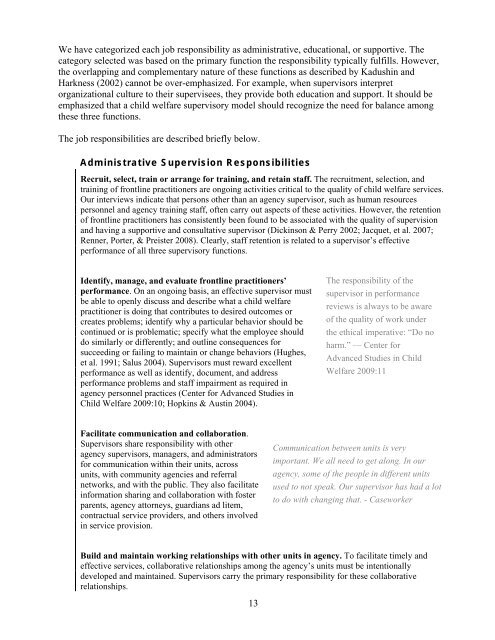Building a Model and Framework for Child Welfare Supervision
Building a Model and Framework for Child Welfare Supervision
Building a Model and Framework for Child Welfare Supervision
- No tags were found...
Create successful ePaper yourself
Turn your PDF publications into a flip-book with our unique Google optimized e-Paper software.
We have categorized each job responsibility as administrative, educational, or supportive. Thecategory selected was based on the primary function the responsibility typically fulfills. However,the overlapping <strong>and</strong> complementary nature of these functions as described by Kadushin <strong>and</strong>Harkness (2002) cannot be over-emphasized. For example, when supervisors interpretorganizational culture to their supervisees, they provide both education <strong>and</strong> support. It should beemphasized that a child welfare supervisory model should recognize the need <strong>for</strong> balance amongthese three functions.The job responsibilities are described briefly below.Administrative <strong>Supervision</strong> ResponsibilitiesRecruit, select, train or arrange <strong>for</strong> training, <strong>and</strong> retain staff. The recruitment, selection, <strong>and</strong>training of frontline practitioners are ongoing activities critical to the quality of child welfare services.Our interviews indicate that persons other than an agency supervisor, such as human resourcespersonnel <strong>and</strong> agency training staff, often carry out aspects of these activities. However, the retentionof frontline practitioners has consistently been found to be associated with the quality of supervision<strong>and</strong> having a supportive <strong>and</strong> consultative supervisor (Dickinson & Perry 2002; Jacquet, et al. 2007;Renner, Porter, & Preister 2008). Clearly, staff retention is related to a supervisor’s effectiveper<strong>for</strong>mance of all three supervisory functions.Identify, manage, <strong>and</strong> evaluate frontline practitioners’per<strong>for</strong>mance. On an ongoing basis, an effective supervisor mustbe able to openly discuss <strong>and</strong> describe what a child welfarepractitioner is doing that contributes to desired outcomes orcreates problems; identify why a particular behavior should becontinued or is problematic; specify what the employee shoulddo similarly or differently; <strong>and</strong> outline consequences <strong>for</strong>succeeding or failing to maintain or change behaviors (Hughes,et al. 1991; Salus 2004). Supervisors must reward excellentper<strong>for</strong>mance as well as identify, document, <strong>and</strong> addressper<strong>for</strong>mance problems <strong>and</strong> staff impairment as required inagency personnel practices (Center <strong>for</strong> Advanced Studies in<strong>Child</strong> <strong>Welfare</strong> 2009:10; Hopkins & Austin 2004).The responsibility of thesupervisor in per<strong>for</strong>mancereviews is always to be awareof the quality of work underthe ethical imperative: “Do noharm.” — Center <strong>for</strong>Advanced Studies in <strong>Child</strong><strong>Welfare</strong> 2009:11Facilitate communication <strong>and</strong> collaboration.Supervisors share responsibility with otheragency supervisors, managers, <strong>and</strong> administrators<strong>for</strong> communication within their units, acrossunits, with community agencies <strong>and</strong> referralnetworks, <strong>and</strong> with the public. They also facilitatein<strong>for</strong>mation sharing <strong>and</strong> collaboration with fosterparents, agency attorneys, guardians ad litem,contractual service providers, <strong>and</strong> others involvedin service provision.Communication between units is veryimportant. We all need to get along. In ouragency, some of the people in different unitsused to not speak. Our supervisor has had a lotto do with changing that. - CaseworkerBuild <strong>and</strong> maintain working relationships with other units in agency. To facilitate timely <strong>and</strong>effective services, collaborative relationships among the agency’s units must be intentionallydeveloped <strong>and</strong> maintained. Supervisors carry the primary responsibility <strong>for</strong> these collaborativerelationships.13
















